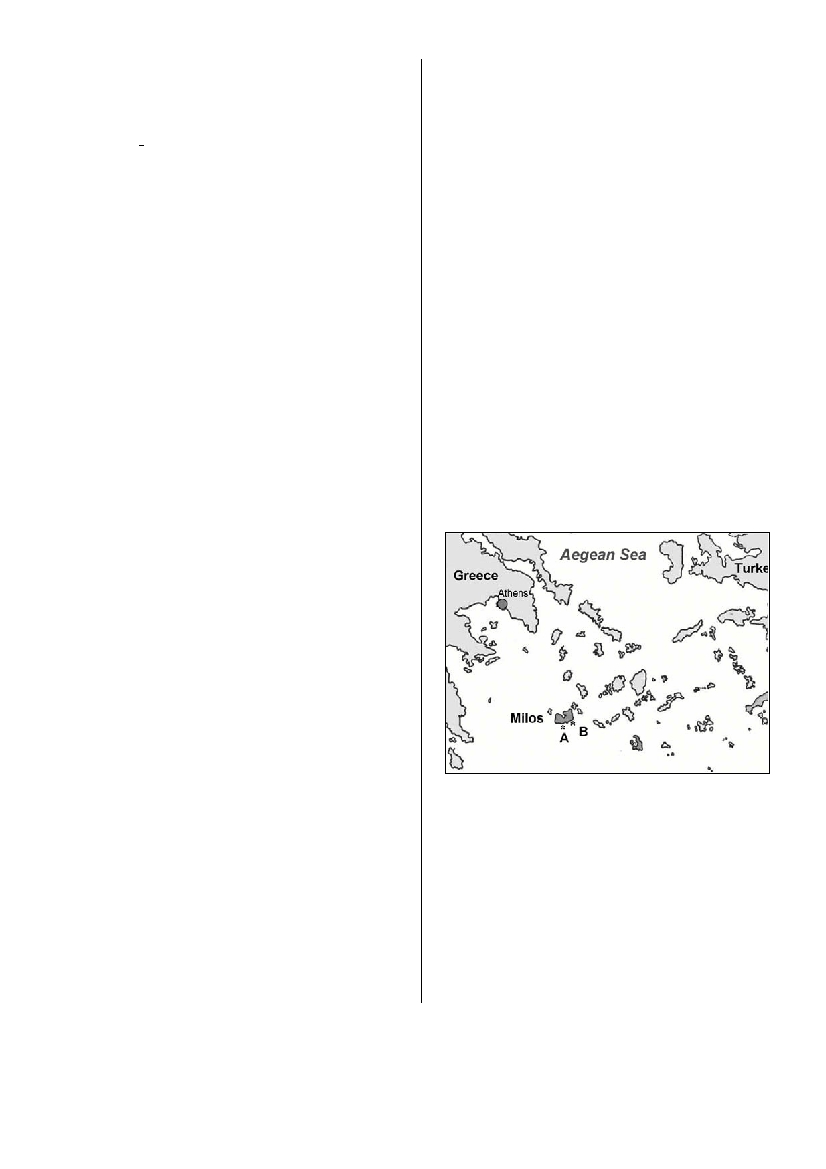Rapp. Comm. int. Mer MÚdit., 36,2001
102
cating that sequestering mechanisms, other than adsorption on com-
pounds, are kinetically slow and unimportant and concern early dia-
gensis for the inorganic phosphorus cycle.
P
org
(range 0.8 ▒ 0.2 to 6.37 ▒ 2.9 Ámol g
-1
) is the most heteroge-
nous phase due to its continuous modification by degradation process-
es constituting between 10 and 60% of Ptot. The coincidence between
chlorophyll
aconcentrations and P
org
suggested that most of the
organic phosphorus is derived mainly from phytoplankton with little
originating from macrophytes or that changes in phytoplanktonic
growth and productivity are related to P
org
remineralization. Organic
phosphorus and organic carbon showed a significant correlation
(R
2
=0.85, p<0.001) suggesting a common origin. Most of previous
studies did not clearly observe such a relationship since P
org
is calcu-
lated by substraction from the P
tot
[5]. For the coastal sediments off
Alexandria, P
org
makes up about 20.9▒3.72% of P
tot
with a mean con-
centration of 6.9▒3.37 Ámol g
-1
[6]. P
org
showed no clear trend in rela-
tion to salinity variations along the mixing zone.
The sum of all extracted P phases was not significantly different
from P
tot
(<6%). Carbonate rich samples showed lower differences
between the sum of species and P
tot
(<1-3%). Generally, the concen-
trations of the P fractions derived for the SE Mediterranean are low
compared to those in other estuaries.
About 1770x10
3
MT y
-1
of suspended matter are discharged to the
SE Mediterranean.Most of this material drifts eastward to Tena Bay
via longshore currents. Low speed currents along the Egyptian coast
(range 11-50 cm s
-1
) permit the fast settling of this material to the bot-
tom.
References
1. Aspila K.I.; Agemian H. and Chan A.S., 1976. A semi- automated
method for the determination of inorganic, organic and total phosphate in
sediments.Analyst,101 : 187-197.
2. Ruttenberg K.C., 1992. Development of a sequential extraction method
for different forms of phosphorus in marine sediments. Limnology &
Oceanography, 37 (7): 1460-1482.
3. Strickland D.H. and Parsons I., 1972. A practical handbook of
seawater analysis. Fisheries Research Board of Canada, Ottawa, 310 pp.
4. Andrieux F. and Aminot A., 1997. A two-year survey of phosphorus
speciattion in the sediments of the Bay of Seine (France). Cont. Shelf.
Res., 17 (10) : 1229-1245.
5. Mach D.L.; Ramirez A. and Holland H.D., 1987. Organic phosphorus
and carbon in marine sediments. Am. J. Sci., 278 : 429-441.
6. El-Sammak A.A., 1994. Preservation of organic phosphorus in shelf
sediments west off the Nile delta, Egypt. Fresenius Envir Bull., 3 : 528-
533.
Introduction
The Aegean Sea is an area of high seismic activity associated with
important geothermal gas venting in shallow waters ranging from 2
to 120 m depth (1). Fluids from the vents, bacteria, and particles pro-
duced in the vent ecosystem are advected by currents and create a
plume that spreads laterally at a level of neutral buoyancy.The geo-
chemical cycling and biological production in these shallow
hydrothermal systems is still largely unknown, particularly with
respect to their importance in the production and export of particulate
organic material. The present paper reports on the chemical compo-
sition of the settling material collected in particle interceptor traps
deployed along the SE coast of Milos (Aegean Sea, Figure 1), in one
area known for its extensive geothermal activity in the seabed (A)
and in another presumed to be free of any major vent in?uence (B).
The distributions of aliphatic and aromatic hydrocarbons and sterols,
as source and maturity chemical indicators, were determined in order
to contribute to a better understanding of the above processes.
Materials and Methods
Moorings were deployed from June to September 1996, to collect
during consecutive periods of 12 days settling particles at 60m over
a bottom of 90m depth. Collected particles (50 mg ▒ 0.1), stored at
ľ20║C until they were processed in the laboratory, were freeze dried
and extracted (3 times) by sonication with 5 ml of dichloromethane
and spiked with cholestane, deuterated pyrene and 5
a
-androstan-3
▀
-
ol as analyte surrogates. The organic extracts were concentrated by
rotary evaporation to 1-2 ml, dried over anhydrous N
a
2SO
4
, and frac-
tioned by column chromatography (5 x 20 mm) with 0.5 g of 3%
water-deactivated alumina. Four fractions were collected: (I) 6 ml of
Fig. 1. Map of the Aegean Sea showing the location of the
moorings. Site Ais located in the vent zone off Paleohori Bay
and site B beyond the in?uence of the submarine vents. Both
moorings were located approximately 1 nautical mile off-
shore, and separated by a distance of about 3.5 nautical

